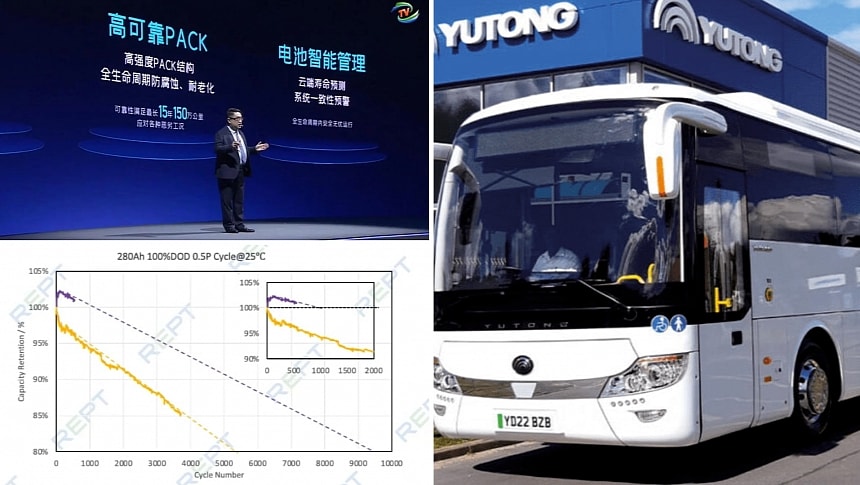CATL recently announced a new type of battery cell that shows no sign of degradation after 1,000 cycles. The cells will be first used by the bus maker Yutong. Thanks to a technique called pre-lithiation, the new CATL battery cells have a very long lifespan. This is why CATL offers a one-million-mile guarantee or 15 years for this battery cell.
CATL is the world's leading battery manufacturer and one of the main suppliers of LFP cells for many carmakers, including Tesla. It's also among the most active in Li-ion battery research and is credited with many innovations that improved LFP cells. Iron-based chemistry was mostly used for stationary batteries because of its low density and long lifecycle. However, improvements to the chemistry made them suitable for use in the automotive industry, and they are now the go-to choice for low-cost electric vehicles.
LFP cells still have lower energy density than their nickel-based counterparts, but the gap is shrinking with every generation. However, LFP cells have more important advantages, including safety, resilience, and costs. We've recently written about discoveries that push the boundaries of what LFP cells can do. Besides much higher energy density, the latest CATL cells, named Shenxing, can also have very short charging times. However, nothing beats a million-mile battery, except maybe a million-mile battery that is dirt cheap.
Based on the latest announcement CATL recently made, the million-mile battery is now officially in production. Yutong, one of China's largest bus makers, is the first to use the new battery cells for its electric buses. The most intriguing characteristic of the new battery cells is that they don't show any degradation after 1,000 cycles. This makes CATL confident enough to offer a 1.5-million km (932,000 miles) 15-year warranty on the battery pack. The bus manufacturer already uses a lesser version of this battery with a 10-year and one million km (621,000 miles) lifespan.
After CATL made the announcement, industry analysts scratched their heads to understand how it's possible for a battery not to experience degradation after the first 1,000 cycles. Normally, the degradation is the fastest in the first 300 cycles, with regular LFP cells expected to lose about 10% of capacity after 1,000 cycles. The curve is mostly linear after that, with 15% degradation after 3,700 cycles and 20% degradation after more than 5,000 cycles.
However, the new technology allows the capacity to remain unaffected after 1,000 cycles. It's not like the cells only start degrading after 1,000 cycles. They improve capacity during the first hundred charging cycles. This is possible by adding additional lithium to the cell, a process called pre-lithiation. Although there are several ways to add lithium to a battery cell, it appears that CATL is adding it to the electrolyte.
The added lithium fills the gaps that appear in the first charging cycles, compensating for the fast degradation during this initial period. It also explains why the capacity goes above 100% before starting to decrease again. The degradation process is also slower with pre-lithiation. The degradation graph shows that the projected lifespan of the LFP cells using pre-lithiation is more than double, with over 9,400 cycles before reaching a 20% degradation.
LFP cells still have lower energy density than their nickel-based counterparts, but the gap is shrinking with every generation. However, LFP cells have more important advantages, including safety, resilience, and costs. We've recently written about discoveries that push the boundaries of what LFP cells can do. Besides much higher energy density, the latest CATL cells, named Shenxing, can also have very short charging times. However, nothing beats a million-mile battery, except maybe a million-mile battery that is dirt cheap.
Based on the latest announcement CATL recently made, the million-mile battery is now officially in production. Yutong, one of China's largest bus makers, is the first to use the new battery cells for its electric buses. The most intriguing characteristic of the new battery cells is that they don't show any degradation after 1,000 cycles. This makes CATL confident enough to offer a 1.5-million km (932,000 miles) 15-year warranty on the battery pack. The bus manufacturer already uses a lesser version of this battery with a 10-year and one million km (621,000 miles) lifespan.
After CATL made the announcement, industry analysts scratched their heads to understand how it's possible for a battery not to experience degradation after the first 1,000 cycles. Normally, the degradation is the fastest in the first 300 cycles, with regular LFP cells expected to lose about 10% of capacity after 1,000 cycles. The curve is mostly linear after that, with 15% degradation after 3,700 cycles and 20% degradation after more than 5,000 cycles.
However, the new technology allows the capacity to remain unaffected after 1,000 cycles. It's not like the cells only start degrading after 1,000 cycles. They improve capacity during the first hundred charging cycles. This is possible by adding additional lithium to the cell, a process called pre-lithiation. Although there are several ways to add lithium to a battery cell, it appears that CATL is adding it to the electrolyte.
The added lithium fills the gaps that appear in the first charging cycles, compensating for the fast degradation during this initial period. It also explains why the capacity goes above 100% before starting to decrease again. The degradation process is also slower with pre-lithiation. The degradation graph shows that the projected lifespan of the LFP cells using pre-lithiation is more than double, with over 9,400 cycles before reaching a 20% degradation.
Purple with LFO pre-lithiation agent pic.twitter.com/6k6ZpwkDuX
— Battery Bulletin (@BatteryBulletin) April 4, 2024








